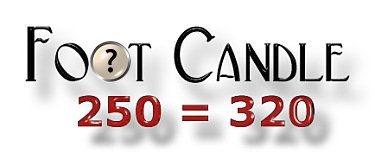
Who had the authority to change Foot-Candle Values?
or
Do you like controversy?


|
|
Back from the early meters in 1947 till 1976 the Foot-candle scale appeared as shown in the top diagram. Then suddenly in 1976 somebody changed the Foot-candle values as shown in the bottom diagram. Definition of Foot-Candle. |

| The Foot-candle numbers were increased with 25%, also added were: 1 - 2 - 4 - 8 -16 - 32 - 64 - 128 (x 30) while the f numbers stayed at their position. If done properly these values must be placed 1/4 stop to the left! |

|
WHY
I can imagine to lengthen the range of the meter to 1.25M.
A little weird though as the f number value for direct reading remained the same.... A quick test showed when I adjusted both meters for 100ASA and turned the dial to 11EV, the outcome was the same 1/60 sec @f 5.6 Amazingly though if I had to quote it, THe High mark on the L-28C2 read 16(x30) foot candles (Direct reading value 2), whereas the L-398 read 20(x30)Foot candles(Direct reading value 2)
Second test with the ASA 100 - 1/60 SLIDE showed the differences also. |
|
IS IT CORRECT?
NOT in my view....!! The Foot-candle numbers increased with 25%, also added were: 1 - 2 - 4 - 8 -16 - 32 - 64 - 128 (x 30) while the f numbers stayed at their position. If done properly these values must be placed 1/4 stop to the left! You can alter C values between a certain limit, but this can't be done with Foot-candles! See also a more visual approach: "The proof is in the scales" Imagine somebody decided to make 1 KG = 1000 gram into 1250 gram. I suppose much more discussions would be provoked. :-) |
|
RESUME
NOTE: So our latest survey exploring Foot-candle values around the Globe turned into confusing entries for our DB. It really makes a difference if somebody tells us 7500 or 9600 Foot candles measured. It does depend what type of meter is used. As said earlier all models from 1947 till 1976 gave the correct answers. Loosely speaking, meters L-398 and on gave more flattering readings! |
| WHO CAN SHED SOME LIGHT? NOTE: This URL has been sent to Sekonic with the kind request to reveal the truth behind this mystery. If you want to comment on this matter mail us here! |
|
Official comments from SEKONIC:
You will find the official reply to the author as a PDF file below.
Official reply from the Sekonic Corporation.(165 KB)(PDF)
|

|
DEFINITION Illuminance is a measure of photometric flux per unit area, or visible flux density. Illuminance is typically expressed in lux (lumens per square meter) or foot-candles (lumens per square foot).
A lightbulb is producing 1 candela. The candela is the base unit in light measurement, and is
defined as follows: a 1 candela light source emits 1 lumen per steradian in all directions (isotropically). A steradian is
defined as the solid angle which, having its vertex at the center of the sphere, cuts off an area equal to the square of its
radius. The number of steradians in a beam is equal to the projected area divided by the square of the distance.
So, 1 steradian has a projected area of 1 square meter at a distance of 1 meter. Therefore, a 1 candela (1 lm/sr) light
source will similarly produce 1 lumen per square foot at a distance of 1 foot, and 1 lumen per square meter at 1 meter.
Note that as the beam of light projects farther from the source, it expands, becoming less dense. For example,
the light expanded from 1 lm/ft2 at 1 foot to 0.0929 lm/ft2 (1 lux) at 3.28 feet (1 m).
|

|
|
|
 |
On the left Brockway-S with a slightly other method (Pointer was set at aperture instead of Foot-candle number, hence the same positions) and on the right side the Sekonic L-28C2. |

|
Author
||| Foot-Candle TEST
||| History
||| Identification
||| Yesterday's Meters
||| HelioValve
||| Model M-3
||| M series
||| FaQ!!
||| Wanted!! ||| SlideShow ||| About slides ||| Condensed Manual Norwood ||| Condensed manual Brockway/Sekonic-S ||| Speed reading ||| Quiz ||| Impressum ||| Friends of ND ||| New Cell? ||| Where to buy ||| E-Mail ||| CD-ROM |




